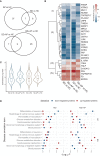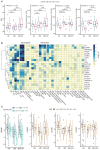Proteomic Analysis of Plasma Markers in Patients Maintained on Antipsychotics: Comparison to Patients Off Antipsychotics and Normal Controls
- PMID: 35546954
- PMCID: PMC9081931
- DOI: 10.3389/fpsyt.2022.809071
Proteomic Analysis of Plasma Markers in Patients Maintained on Antipsychotics: Comparison to Patients Off Antipsychotics and Normal Controls
Abstract
Background: Schizophrenia (SZ) and bipolar disorder (BD) share many features: overlap in mood and psychotic symptoms, common genetic predisposition, treatment with antipsychotics (APs), and similar metabolic comorbidities. The pathophysiology of both is still not well defined, and no biomarkers can be used clinically for diagnosis and management. This study aimed to assess the plasma proteomics profile of patients with SZ and BD maintained on APs compared to those who had been off APs for 6 months and to healthy controls (HCs).
Methods: We analyzed the data using functional enrichment, random forest modeling to identify potential biomarkers, and multivariate regression for the associations with metabolic abnormalities.
Results: We identified several proteins known to play roles in the differentiation of the nervous system like NTRK2, CNTN1, ROBO2, and PLXNC1, which were downregulated in AP-free SZ and BD patients but were "normalized" in those on APs. Other proteins (like NCAM1 and TNFRSF17) were "normal" in AP-free patients but downregulated in patients on APs, suggesting that these changes are related to medication's effects. We found significant enrichment of proteins involved in neuronal plasticity, mainly in SZ patients on APs. Most of the proteins associated with metabolic abnormalities were more related to APs use than having SZ or BD. The biomarkers identification showed specific and sensitive results for schizophrenia, where two proteins (PRL and MRC2) produced adequate results.
Conclusions: Our results confirmed the utility of blood samples to identify protein signatures and mechanisms involved in the pathophysiology and treatment of SZ and BD.
Keywords: antipsychotics; biomarkers; bipolar disorder; metabolic syndrome; proteomics; schizophrenia.
Copyright © 2022 Engelke, Ouanes, Ghuloum, Chamali, Kiwan, Sarwath, Schmidt, Suhre and Al-Amin.
Conflict of interest statement
SO and SG were employed by Hamad Medical Corporation. The remaining authors declare that the research was conducted in the absence of any commercial or financial relationships that could be construed as a potential conflict of interest.
Figures



References
-
- American Psychiatric Association . Diagnostic and Statistical Manual of Mental Disorders: DSM-5. Arlington, VA: Amer Psychiatric Pub Incorporated; (2013). 10.1176/appi.books.9780890425596 - DOI
Associated data
LinkOut - more resources
Full Text Sources
Research Materials
Miscellaneous

